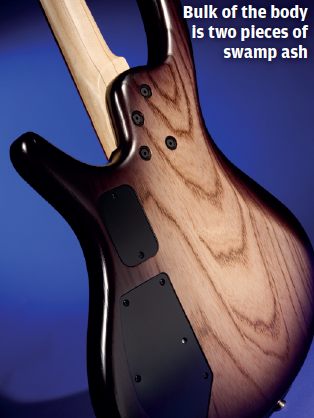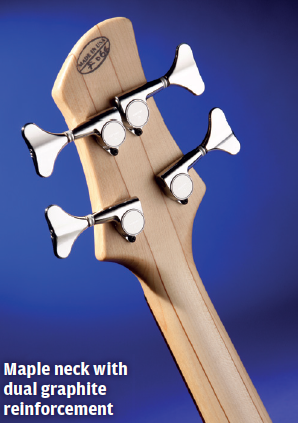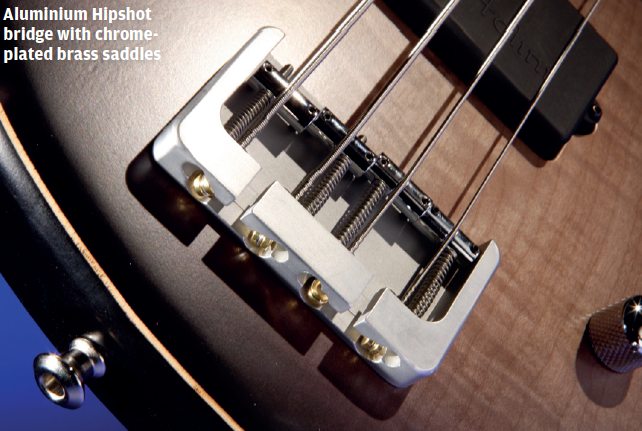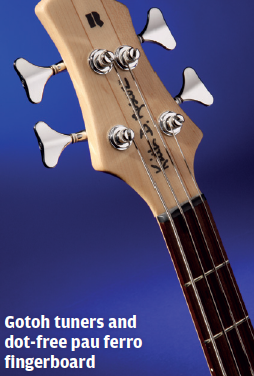Related Tags
Roscoe Century Standard Plus 4JM Bass
Roscoe’s Century Standard is tasteful, streamlined and well-equipped – and the ‘Plus’ option gets you a sweet maple top.

Details
Description: Solidbody bass. Made in the USA
Price: £2364 inc. hard case
Contact: Bass Direct 01926 886 433 www.bassdirect.co.uk
This month we’re firing up the reviewing furnace and shovelling in another high-end bass with boutique leanings. During the last year or so we’ve been graced by excellent basses from Sandberg, NS and Elrick hovering in or just outside the £1500-£2500 bracket, so it’s comforting to start the new one with another fine example.
 Roscoe Guitars hail from Greensboro, North Carolina, and the company emerged in 1980 from an instrument repair and, later, instrument building business set up by Keith Roscoe nine years earlier. Roscoe is a classic example of musician-turned-luthier, learning guitar from the age of 10, jumping over to bass a few years later when an opportunity presented itself.
Roscoe Guitars hail from Greensboro, North Carolina, and the company emerged in 1980 from an instrument repair and, later, instrument building business set up by Keith Roscoe nine years earlier. Roscoe is a classic example of musician-turned-luthier, learning guitar from the age of 10, jumping over to bass a few years later when an opportunity presented itself.
He established his repair business straight from school and eventually started building his own guitars because ‘after you’ve repaired or restored 10,000 guitars you start thinking “I could build these myself”’. The business initially focused on guitars but by the late ’90s the situation had reversed, leading Roscoe to focus solely on building basses.
 Whilst you can find Roscoe basses on the shelf, so to speak, there are plenty of options available if you choose to order one, from fingerboard wood to hardware colour, headless construction or optional Aguilar pickups. The Century Standard Plus we’re reviewing this month has a Bartolini J/MM pickup combination that adds £165 to the basic £2199 starting price.
Whilst you can find Roscoe basses on the shelf, so to speak, there are plenty of options available if you choose to order one, from fingerboard wood to hardware colour, headless construction or optional Aguilar pickups. The Century Standard Plus we’re reviewing this month has a Bartolini J/MM pickup combination that adds £165 to the basic £2199 starting price. In form, the CSP represents an intelligent modern take on a recognisable template, with sweetly offset rear bouts lifted straight from the Fender Jazz template, although Roscoe have shortened the body’s overall length to move the waist section by about 20mm, a small alteration that results in almost perfect balance in the seated position. While the lower bout becomes fractionally shallower towards the top edge, it’s not what you’d call a chamfer, but there’s an extensive ribcage provision around the back.
In form, the CSP represents an intelligent modern take on a recognisable template, with sweetly offset rear bouts lifted straight from the Fender Jazz template, although Roscoe have shortened the body’s overall length to move the waist section by about 20mm, a small alteration that results in almost perfect balance in the seated position. While the lower bout becomes fractionally shallower towards the top edge, it’s not what you’d call a chamfer, but there’s an extensive ribcage provision around the back.
The Jazz likeness lessens when you get to the horns: the upper horn is thin and elongated to fall just short of the 12th fret, while the lower is cut away for great access to the highest fret.
The body is made from two pieces of swamp ash, centrally spliced. You can clearly see the gorgeous sweeping grain of the ash on the back, but the top carries a beautifully marbled flame maple top with a Charcoalburst finish with a satin lacquer coat; some might prefer a glossy sheen, but we think it looks dead cool. Note that the light coloured line is not representative of a sandwich layer, merely a decorative detail added during the finishing process. Blimey, these chaps have seriously steady hands.
 The neck is a three-piece maple affair, each section delineated by a light brown stringer that could be walnut. It’s secured to the body using four Allen bolts through a heel that shallows slightly towards the lower cutaway, a nice detail that further improves the access up top.
The neck is a three-piece maple affair, each section delineated by a light brown stringer that could be walnut. It’s secured to the body using four Allen bolts through a heel that shallows slightly towards the lower cutaway, a nice detail that further improves the access up top.
The neck’s shallow ‘C’ contour makes it ultra-comfortable under the hand, and the unfussy hourglass headstock is nicely back-angled to create the requisite break angle for the strings at the black Graphtech nut. The front displays the maker’s signature and logo plus four lightweight chrome Gotoh tuners in two up/two down configuration.
 Roscoe employs pau ferro (also known as Brazilian ironwood or leopard tree, found in Brazil and Bolivia) for the fingerboard, which carries 24 expertly-seated medium nickel frets and no front position markers, just side markers. Trussrod access is at the body end, with access facilitated by a carved half-moon slot that proudly takes its place as an element of the design. The CSP has aluminium Hipshot B Style bridge with ‘brushed’ finish; it’s a simple and effective unit, a nice, sturdy update on a traditional design.
Roscoe employs pau ferro (also known as Brazilian ironwood or leopard tree, found in Brazil and Bolivia) for the fingerboard, which carries 24 expertly-seated medium nickel frets and no front position markers, just side markers. Trussrod access is at the body end, with access facilitated by a carved half-moon slot that proudly takes its place as an element of the design. The CSP has aluminium Hipshot B Style bridge with ‘brushed’ finish; it’s a simple and effective unit, a nice, sturdy update on a traditional design.
The CSP has a pair of Bartolini pickups, a J model at the neck and an MM in the bridge position, and these are hooked up to a Bartolini 4.6AP 918 three-band preamp built to Roscoe’s own specifications. As well as Volume and Pan knobs there’s a Mid control that, if you give it a tug, changes the mid frequency from 800Hz to 250Hz (basically, brighter to darker), Bass/Treble in stack knob form, and a three-position coil tap switch: bridge position is series mode, down is parallel mode, and centre is single coil.
 Sounds
Sounds
With EQ flat and the switch in single-coil mode (centre), the Roscoe’s basic tone seems excellent – a pleasing growl from the E string, plenty of width and clarity with a slight zing in the midrange and clean, well-realised highs that open out nicely when you dig in. In series mode (bridge) there’s more body to the midrange but the highs are a fraction duller and the E string loses some of its gunning edge, while in parallel mode some raspy acoustic qualities emerge and highs are softer and more melodic.
Most of us will more than likely choose one setting and stick with it (we’re using single-coil mode here) but it’s really well worth spending time on any of these options.
Keith Roscoe talks about sensing the tonal properties of a piece of wood when he selects it and monitoring this throughout the construction process. When you start to EQ the CSP, you might hear what he means; it’s nothing radical, but there’s something happening underneath, and the bass really comes to life. Dial in some low and you can feel it in your gut, yet this thickening takes place without destroying other frequencies, retaining softer but still well-defined highs.
 There is a slight nasal zing that can be removed by backing off the Mid a little at 800Hz, although be careful with the cut or you’re in scooped mids territory, and that’s not a very nice place to be. Boosting mid level induces a fine, fat finger-funk sound or, with a tug on the knob, a huge, punchy tone that only starts to sound boxy on full boost. The Treble control moves you from a little extra brightness to crunch before hitting you with vicious, cutting attack for an effective modern slap tone.
There is a slight nasal zing that can be removed by backing off the Mid a little at 800Hz, although be careful with the cut or you’re in scooped mids territory, and that’s not a very nice place to be. Boosting mid level induces a fine, fat finger-funk sound or, with a tug on the knob, a huge, punchy tone that only starts to sound boxy on full boost. The Treble control moves you from a little extra brightness to crunch before hitting you with vicious, cutting attack for an effective modern slap tone.
The individual pickup variations are also good: the neck pickup is dark and old-school, but boost bass and middle a lot and treble a little and the nasty, crunching assault must be very close to a perfect modern take on the P-Bass. Perform the same moves on the bridge pickup and you’ll find a super-tight sound with generous high-mid gurgle but coated with ample bottom end and a touch of treble spite. It may sound like a strange and impractical mixture, but it’s a great setting for serious fun.
Verdict
If you’re going to invest a large chunk of your savings on a bass then it has to be good, and the Roscoe Century Standard Plus is really, really good. The build quality is excellent, and the design is an sleek, appealing take on a classic. It’s relatively light, and the balance is excellent. The coil-tap switch and powerful, musical EQ means loads of tonal options, and the neck is superbly playable. So if you’re looking to make a one-time investment in a life-changing bass, we’d suggest nudging a Roscoe to the top of your ‘must see’ list.
